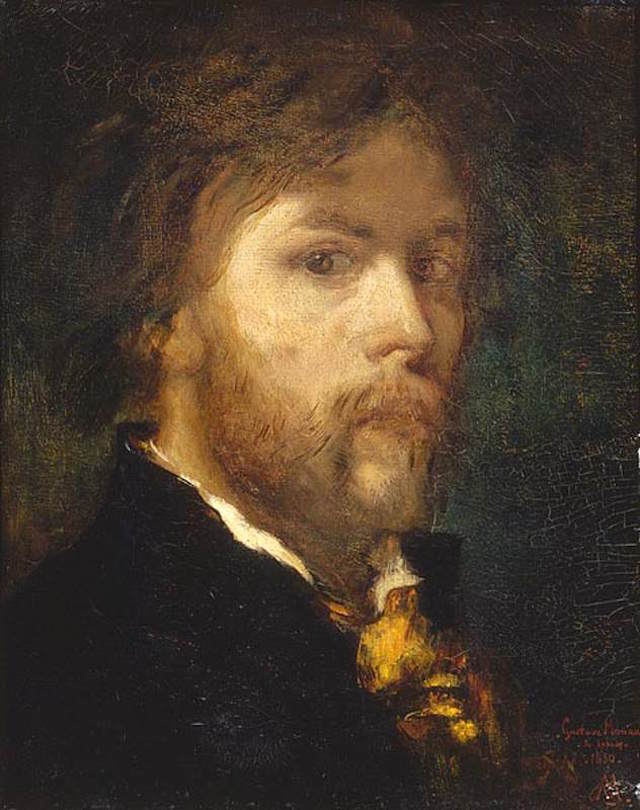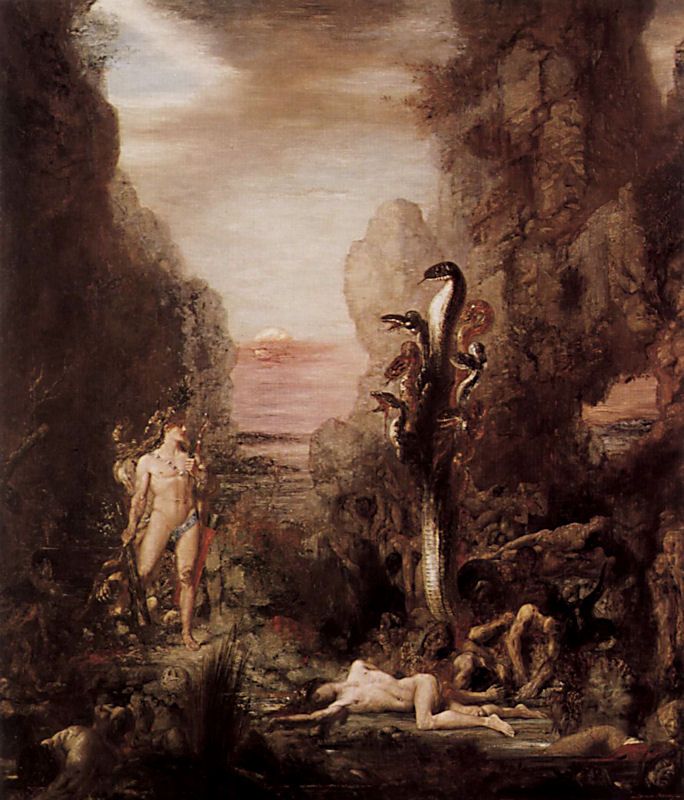
A self-portrait of Moreau, painted in 1850
I feel like I’ve got a bit of a strange relationship with the span of Impressionism movements. I can appreciate the creative risks these painters took in confronting a restrictive status quo and a cultural climate dominated by expectations of the salons and academies of the era, but at the same time many of the paintings don’t resonate with me in quite the same way the work of previous eras does. Particularly with many of the landscape pieces and more abstract works. I think I’m perhaps more moved by theme and the unique rendering of certain subject matter than clever play of colour and aesthetic sense we were seeing in many of the landscapes and Parisian life scenes during lecture slides. That’s a bit strange for me as well, because I found that I quite like painting in a slightly more impressionistic style when I first tried acrylics with Andrew during his continuing studies course.

Hercules and the Hydra Lernaean (1876). The way this is framed and the rendition of the hydra not as a massive creature as we often see in contemporary art, but as a more modest and grounded monster composed of actual serpents is strangely compelling. It brings it to a more believable level (or as believable as a regenerating nine-headed snakebeast can be, at the very least).
I ended up finding Gustave Moreau after diving through several of the other artists of the era and had a nice double take moment with his work. At the risk of perhaps becoming somewhat predictable, I was drawn in once more by strong themes of mythological and biblical imagery/symbolism, bold light and a slightly unsettling, haunted atmosphere.

Le Poète et La Sirène (1893). Another piece with lovely and strong vertical framing. Something I’ve noticed is many of his subjects seem to share a witheringly intense gaze; the siren here has so much of the white of her eyes exposed it gives a deeply unsettling feeling as she levels her gaze at the poet. His colours in this work are also beautiful, with two of my favorite combinations really popping out here. The range of blue-greens and the soft red corals are striking and wonderful focal points supporting the starkness of the flesh tones.
As I understand it, he’s a forerunner of the Symbolist movement and ended up developing a particularly unique style through travel initiated by a series of personal tragedies. He was enamored with books like The Grammar of Ornament and Le Costume Historique and would incorporate bits of the exotic into his compositions, giving him a style that I find quite unique and bold for the period. A great example of this is the following painting, L’Apparition.

The Apparition (1876). An intensely different take on the beheading of John the Baptist than what we typically see in most classical depictions. The rendering of the supernaturally floating head reminds me somewhat of Grunewald’s final panel of the Isenheim altarpiece; beautiful, intensely striking and eerie. Both seemingly ahead of their time in their way of interpreting their respective scenes. The architecture and costuming shows a clear exotic (but not necessarily culturally specific) influence drawing from the earlier books we know he was fond of. He’s got an interesting pastiche of cultural influences that end up creating something quite unique.
Something I thought was also a bit neat going through his work was finding a very famous contemporary artist extolling the work of Moreau and what a direct influence it was on his unique style. Yoshitaka Amano made many of the illustrations for fantasy works throughout the 80s, and was an artist a lot of my friends and peers were enamored with. He has a wispy, beautiful but very unique style that he developed by studying Moreau’s method of painting when he was young and still trying to find his own art style.
-www.kaifineart.com-29.jpg)
One of Amano’s illustrations for comparison.
Compare that to a piece like Salomé, pictured below. I feel like a clear influence can be seen from the character art, as well as the languid and wispy lines. Somewhat similar in colour palette, a trend I noticed in a few of his other works as well. Kind of an interesting thing to find out as a little easter egg, as Amano is now quite famous and influential in his own right outside of his native Japan.

Salomé (1876). Shrouded, haunting figures and exotic architecture paint a scene that I find almost reminiscent a more ethereal and genteel Frazetta piece, a century beforehand. This is an intensely interesting take on what feels to be almost a sort of proto-fantasy. His costuming and techniques are striking and wildly inventive compared to what I was seeing from his contemporaries at the time.
All in all, a pretty interesting artist for me personally. He’ll be one I’ll be referencing and revisiting several more times in future.
Sourcing
https://www.theartstory.org/artist-moreau-gustave.htm
http://www.getty.edu/art/collection/artists/329/gustave-moreau-french-1826-1898/
Images
http://www.artcyclopedia.com/artists/moreau_gustave.html
https://en.wikipedia.org/wiki/Gustave_Moreau#/media/File:Gustave_Moreau_Salom%C3%A9_1876.jpg

Leave a Reply